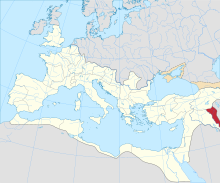Assyria (Roman province)
| Province of Assyria Provincia Assyria ( Latin) | |||||||||
|---|---|---|---|---|---|---|---|---|---|
| Province of the Roman Empire | |||||||||
| 116–118 | |||||||||
 The province of Assyria in 117 AD, where was highlighted in red | |||||||||
| Historical era | Antiquity | ||||||||
• Established by Trajan | 116 | ||||||||
• Evacuated by Hadrian | 118 | ||||||||
| |||||||||
| Today part of | |||||||||
Assyria (/əˈsɪəriə/) was a short-lived Roman province in Mesopotamia that was created by Trajan in 116 during his campaign against the Parthian Empire. After Trajan's death, the newly proclaimed emperor Hadrian ordered the evacuation of Assyria in 118.
History
According to
There is
Despite Rome's military victory, Trajan's 116 conquest was plagued with difficulties. From the start, a Parthian prince named Santruces organized an armed revolt by the native peoples, during which Roman garrisons were driven from their posts and a Roman general was killed as his troops tried to stop the rebellion.[5] Trajan overcame the revolt, capturing and burning Seleucia and Edessa, and even setting up a puppet Parthian king; but then, on his journey homeward in triumph, he fell sick and died on 8 August 117.[1]
Trajan's successor, Hadrian, implemented a new policy with respect to the recently acquired territories in the east. Believing that they overextended the Empire, he withdrew to the more easily defensible borders.[6][7] He left unfinished the work of overcoming the Parthians, which he saw would require an excessive increase in military spending. He sent the puppet Parthian king elsewhere and restored to the former ruler the lands east of the Euphrates, together with his daughter who had been captured, preferring to live with him in peace and friendship.[8]
Location
The fourth-century historians Eutropius and Festus assume that the supposed Roman province of Assyria was situated "east of the Tigris and usually identified with
Further Roman activity in Mesopotamia
Hadrian's withdrawal in 118 did not mark the end of Roman rule in Mesopotamia. A second Parthian campaign was launched from 161-165 under the command of Lucius Verus, with the Roman army once more conquering territory east of the Euphrates.[11] Rome pursued military action against the Parthians again in 197-8 under the command of emperor Septimius Severus.[12]
Following his successful campaign, Septimius Severus instituted two new Roman provinces:
Despite continued Roman activity in the region, no further reference is made to a Roman province of Assyria following Hadrian's evacuation in 118 AD. When Septimus Severus created the provinces of Osroene and Mesopotamia at the end of the 2nd century, no mention is made of a Roman province of Assyria.
The Roman historian
Thus, it seems that the province of Assyria only existed during Trajan's reign, if even then, and was not reinstated during later Roman occupations of the region. The general area coincided with ancient
See also
- Asuristan
- Osroene
- Achaemenid Assyria
- Syria (Roman province)
- Mesopotamia (Roman province)
- History of the Assyrian people
- Romans in Persia
- Roman Armenia
References
- ^ a b Theodore Mommsen, Römische Geschichte (Berlin 1885), vol. V (Die Provinzen von Caesar bis Diocletian), pp. 400−401
- ^ C. S. Lightfoot, "Trajan's Parthian War and the Fourth-Century Perspective" in The Journal of Roman Studies, Vol. 80 (1990), pp. 115-126
- ^ a b c Erich Kettenhofen, "Trajan" in Encyclopædia Iranica (2004)
- ^ Simon Grote, "Another look at the Breviarium of Festus" in The Classical Quarterly, Volume 61, Issue 2 (December 2011), pp. 704-721
- ^ David Magie, Roman Rule in Asia Minor to the End of the Third Century After Christ, Princeton, NJ: Princeton University Press, 1950: p. 609.
- ^ Charles Freeman, The World of the Romans, New York: Oxford University Press, 1993: p. 62.
- ^ The Cambridge Ancient History, Volume XI, London: Cambridge University Press, 1970: p. 640.
- ^ Theodore Mommsen, Römische Geschichte (Berlin 1885), vol. V (Die Provinzen von Caesar bis Diocletian), p. 403
- ^ C.S. Lightfoot, "Trajan's Parthian War and the Fourth-Century Perspective," The Journal of Roman Studies, Volume 80, (1990), p. 121-122.
- ^ Lightfoot p. 121; Magie p. 608.
- ^ The Cambridge Ancient History p. 640.
- ^ Magie p. 674-5; Fergus Millar, The Roman Empire and its Neighbors, London: Weidenfeld and Nicolson, 1967: p. 211.
- ^ Matthew Bunson, A Dictionary of the Roman Empire (Oxford University Press 1995), p. 303
- ^ Magie p. 674-5; Fergus Millar, The Roman Empire and its Neighbors, London: Weidenfeld and Nicolson, 1967: p. 211.
- ^ Ammianus Marcellinus The Later Roman Empire (354-378) A shameful peace concluded by Jovian 6.7 pg.303, Penguin Classics, Translated by Walter Hamilton 1986
- ^ Ammianus Marcellinus, Rerum gestarum libri 23.6.20
- ^ Ammianus 23.6.14−15
- ^ Ammianus, 23.6.23
- ^ Ammianus 23.2.6
- ^ Ammianus 23.3.1

